15 Mistakes You're Probably Making With Mashed Potatoes
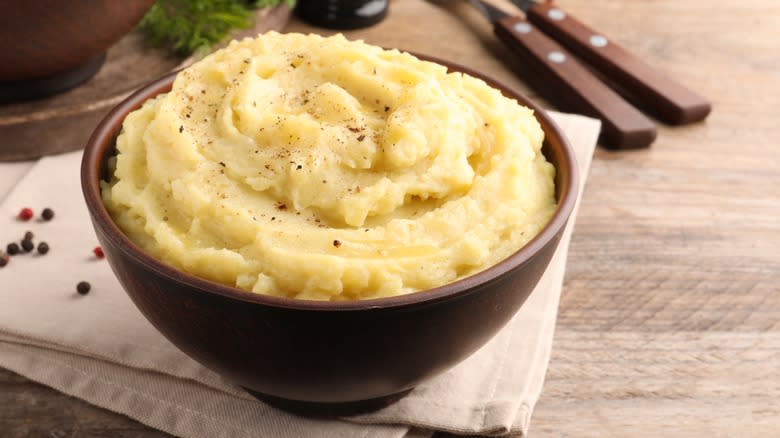
A piping hot serving of buttery mashed potatoes makes a delicious side dish, no matter the occasion. It's a cozy and comforting carbohydrate that's a staple in many homes throughout the year. Whether you like it, smooth, lumpy, skin on, or skin off, there are many ways to make mashed spuds taste high-quality. However, there are some mistakes you're probably making with mashed potatoes that you might not have considered. Take a look at our tips, which include preparation techniques, ingredient inclusions, and quick fixes, and see if there are any changes you can apply next time you make these potato delights.
From not using fragrant fresh herbs to only boiling your potatoes in water, these are some common mashed potato-making mistakes and how to fix them. Some tips are easy tweaks whereas others involve more time, ingredients, or tools. Refer back to these hacks to give your potatoes a boost in ways you wouldn't expect. No matter what consistency you prefer your tots to be, you're sure to find a tip or two to turn your smashed spuds into a crowd-pleaser.
Read more: 23 Types Of Potatoes And When To Use Them
Failing To Salt The Water
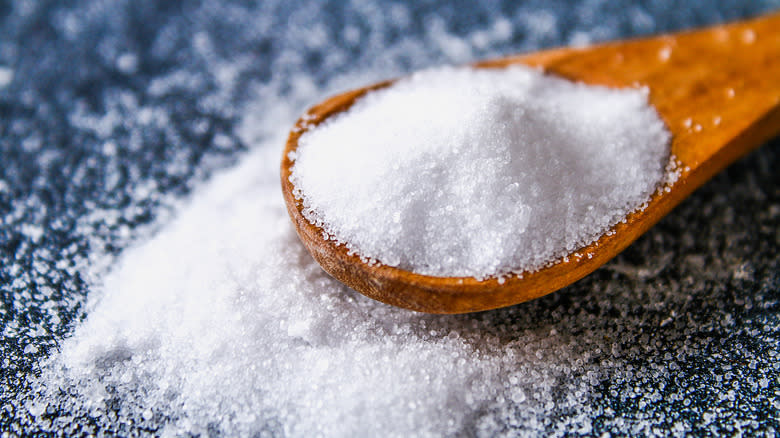
Next time you make potatoes for the family, add a generous heap of salt to the water. It might seem unimportant but it's actually an imperative step of the mashed potato-making process. It's the same technique as adding salt to pasta as it not only acts as a seasoning but it also helps add flavor from within. The entire tuber will infuse with flavor rather than just the outer portion, making for a flavorful mash.
When you don't salt the water or add a minuscule amount of salt you're missing out on layers of flavor that are infused throughout the whole potato during the cooking process. Instead of table salt, go for sea salt or kosher salt. You could do a flavored salt, such as smoked or truffled, but the taste will be nuanced since the water will be strained. This is a decent option when you want to incorporate flavor that won't bulldoze the overall taste. Give your dish more flavor and always salt the water when making mashed potatoes.
Dicing The Potatoes Unevenly
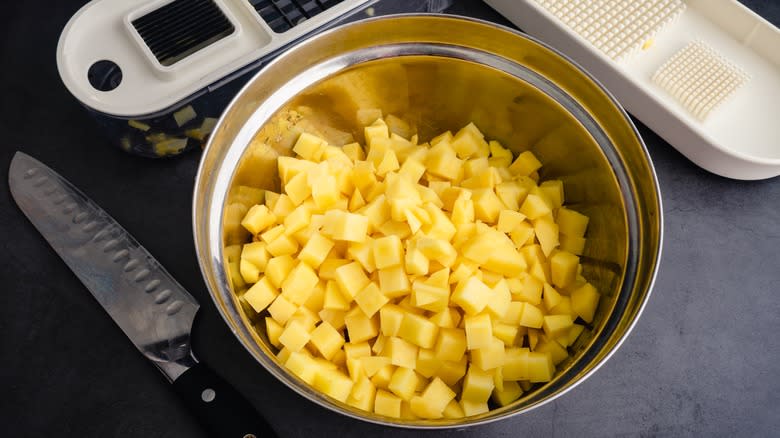
Sometimes life gets in the way, there's a lot of traffic, you're running late, and you're rushed to make dinner. You quickly and haphazardly chop your potatoes and drop them into water to boil. Once you begin mashing, something feels off. Although it might seem like it won't make a difference, the uneven sizing can mess up your tubers. When the spuds are uneven, they'll cook at different rates, making some pieces completely mushy and overcooked while other pieces are firm and undone. This might be the reason your mashed tots differ each time you make it, ranging from mushy to firm.
To cure this, apply this top: Cut your potatoes evenly in a simple large dice. Evenness is just as helpful as shape. You don't have to do anything fancy, such as any type of wedges or slices since these will all ultimately end up smooshed. Use a sharp knife and chop away. This rule for preparing mashed potatoes will give you an even texture every time, which is useful so you aren't left with a combination of mushy spuds as well as hard and lumpy ones.
Not Adding In Something Creamy
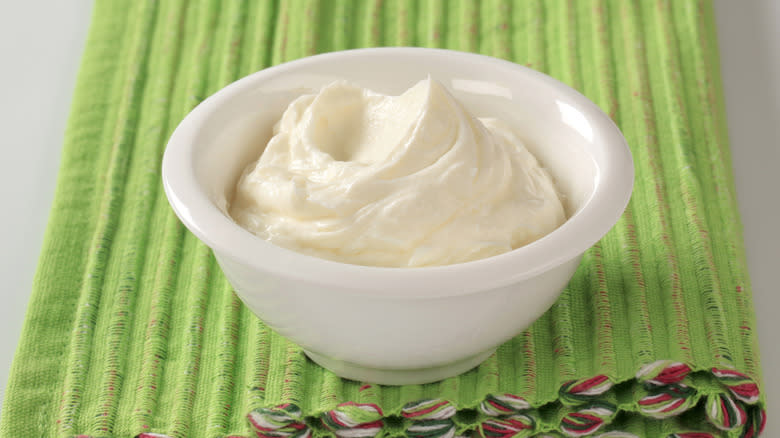
Pouring in sour cream, cream cheese, crème fraîche, or mayonnaise will up the richness of your mashed potatoes, so they resemble something from a nice restaurant. It provides a velvety quality while completely enhancing the flavor. Taters are amazing on their own, but mashed tubers have never been something where they're literally only made with potatoes. There are always other components from salt to milk; adding in something more creamy than milk allows the opportunity for it to have a sleekness and further develop the flavor.
A creamy addition tastes good on the tongue and can provide different flavor profiles, whether you're choosing tangy sour cream in your potatoes, lightly sour but slightly nutty crème fraîche, or mild and dense cream cheese. Mayo might be an unexpected condiment, but it's an easy add-in to give your potatoes a delightful texture. Try mayo's cousin aioili if you want something with a deeper flavor. This is a simple mistake to fix because there are so many milk and cream-based options that you can integrate into your next batch of mashed taters.
Trying Only The Hot Version
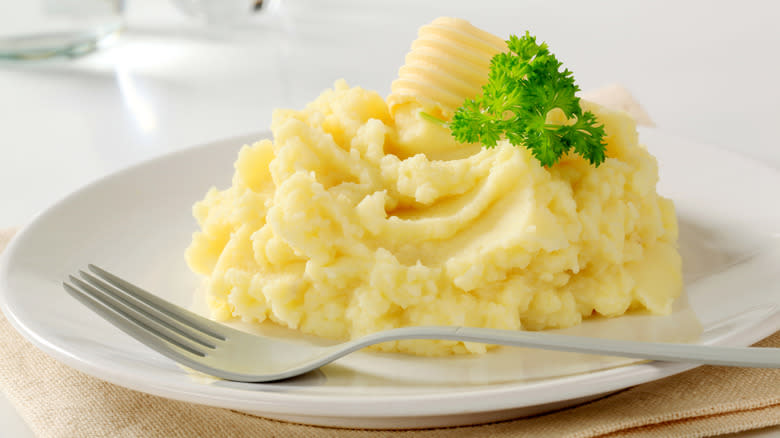
Mashed potatoes are a well-known hot side dish that's often served along with meat and some sort of vegetables. We're here to tell you it's a mistake to only it hot and that it's high time to experiment with cold mashed potatoes. On a hot day in the summertime, you might want to try chilled mashed potatoes, instead. You make it similarly to the classic mashed potatoes by first boiling and then mashing spuds. Season it to your taste with salt, pepper, garlic powder, or paprika. Let it chill in the fridge, and top it with chives or green onions when it's ready to serve.
We love hot mashed potatoes just as much as anybody, but this is a fantastic option to keep in your back pocket when you're looking to try something different to have a cold dish on a hot day. Think of it as the cousin of potato salad, so large chunks are welcome, as well as integrating condiments like spicy mustard or a dollop of mayonnaise. This is an ideal dish to bring to a picnic or serve at a gathering since you don't have to worry about it cooling off.
Forgetting The Cheese
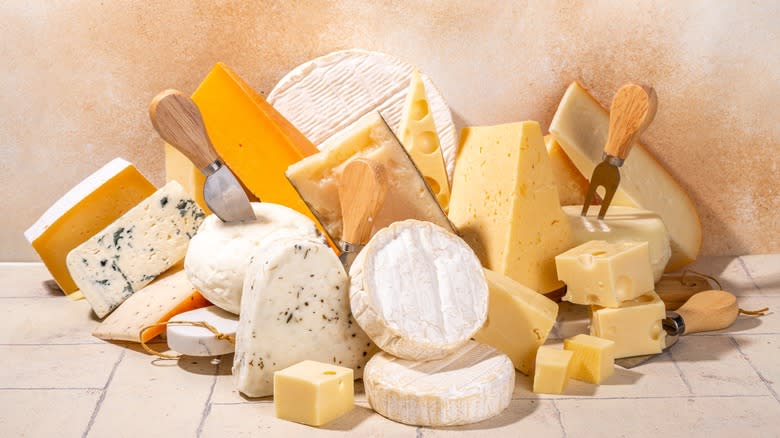
Cheese is one of those ingredients that makes most things taste better, whether that's a sandwich or a veggie dish. There's really no rule on what cheese to add to your mashed spuds since it depends on your taste preferences. Give your potatoes an upgrade with mild cheddar or white cheddar. Choose a cheese, such as mozzarella, to switch up the texture of your tubers. Mozzarella will have more of a stringy cheese pull action, whereas baking mashed potatoes with feta might provide a pop of creamy, salty cheese. Well-cooked feta isn't as dense as it would be cold, but it does retain a decent amount of its bite.
Adding blue cheese to mashed spuds might not be everyone's cup of tea, but it's a captivating option with a distinct blue cheese taste. There are plenty of cheeses out there that pair well with smooshed spuds. You don't have to use one cheese at a time either. Sometimes the more is, in fact, the merrier. Cheddar cheese and mozzarella go together beautifully as well as Gruyère and Parmesan.
Not Baking Your Mashed Potatoes
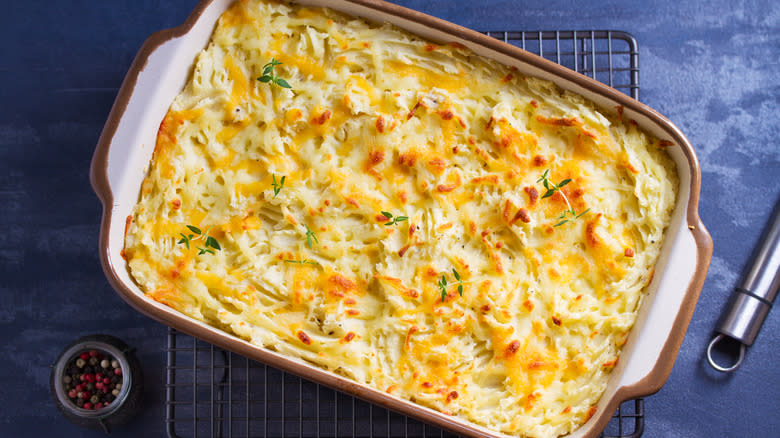
If you're a baked potato fan, you might want to try baking your mashed potatoes. It has your classic combination of butter, milk, and tubers, but you get to cook them again during a baking process in a similar vein to twice-baked potatoes. Boil, mash, and season your tots appropriately, then drop them into a nicely buttered baking dish. Place them in the oven to heat thoroughly, and if need be, broil for a minute or two toward the end to give it a slight crust.
No matter how long you broil it, keep an eye on it the entire time; it can go from golden brown to burnt quickly. You can keep it simple or top it with cheese or fresh herbs for aromatics. The baked version will have a density to it because the baking process evaporates excess moisture. If you ever have runny mashed spuds, this might be a good option to try to resuscitate them into something thicker. Try an alternative serving method with a batch of baked mashed potatoes.
Starting With Hot Water
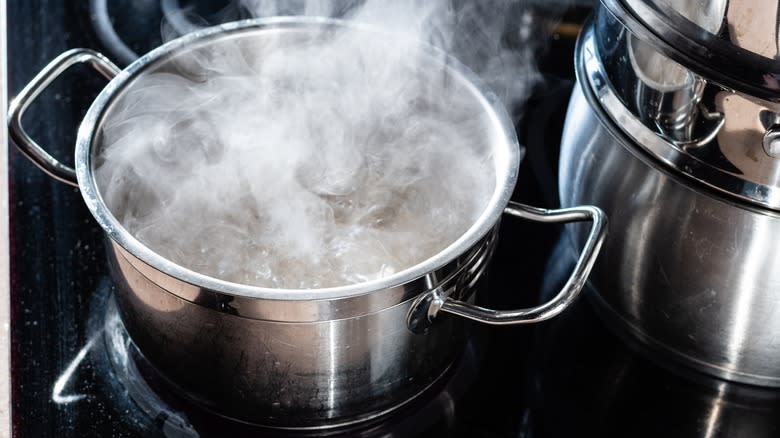
As far as mistakes you're probably making with mashed potatoes, keeping your water cold before adding the tots is one of the easiest fixes. It might seem like a good way to cook your food faster, but there's no need to heat or boil the water ahead of time. While plopping your taters in hot water isn't going to turn your spud dish into something inedible, it does mess with the cooking rate of the potatoes. It will cook the outside of the potato faster than the inside, giving an uneven cooking rate for a mix of mushy and firm spuds. The outside cooks within a couple of minutes while the inner portion remains firm.
When you poke your fork through, it might give the illusion that it's completely cooked, but it's not. Correct this blunder by putting the potatoes in cold water and then bringing them up to a boil. This method applies to any type of tot you end up using. Boil potatoes correctly by placing your diced potatoes in cold or room temperature salted water, then gradually bring them to a boil.
Tossing Out The Potato Water
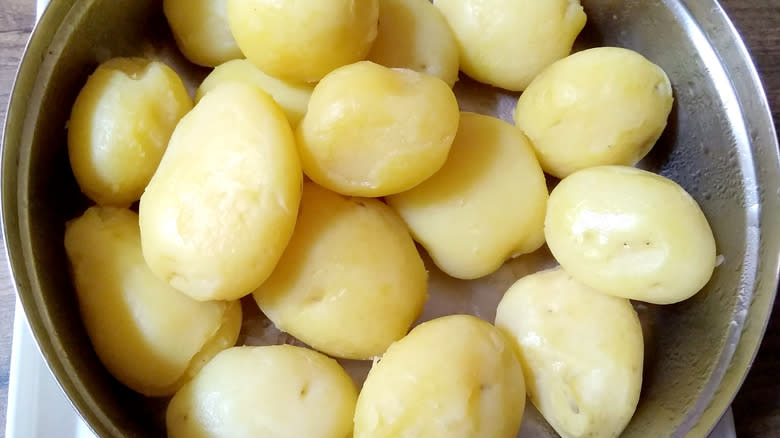
Your spuds are tender and ready for mashing. You're just about to strain them when you think otherwise. You're on the right track, since that potato cooking water contains flavor from the salt and can be used as a thickening agent to give your mashed spuds some body. But there's no need to keep all the water; a couple of tablespoons will do. Discarding all of the water is a mistake since it can contribute to a silky consistency without having to load up on butter or cream.
This is a nice option to have if you want restaurant-quality mashed potatoes or you don't want as much fat content in them. To apply this tip, use a bit of starch water and lessen the amount of milk you pour in. The potato water will leave your mashed tots moist and flavored with minimal effort, and it's the same approach as using your pasta water in your pasta. It's starchy and salty, perfect for thickening up loose spuds. Stop pouring out your potato water: It's a very easy fix and you'll notice the difference once you make the switch.
Omitting The Herbs
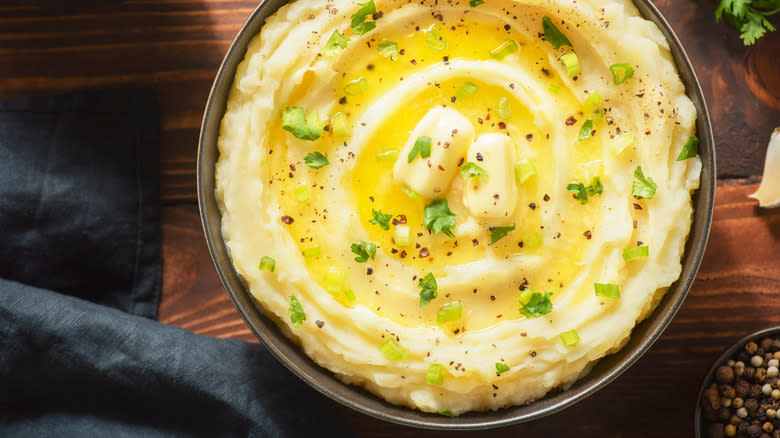
Who doesn't love herbs, particularly fresh ones? They are fragrant and tasty, and there's such a wide variety to choose from. Garlic is a popular option in mashed potatoes, but there's a whole garden of herbs to pick from. Dried herbs work just as nicely and last longer in the spice cabinet, so there's no worrying about slimy, old herbs. Herbs can upgrade your mashed taters into a gourmet side without a lot of effort. You only have to rinse, chop, and then stir them in, or a quick shake, shake, shake if using dried herbs.
Rosemary, sage, and thyme are some of the top herbs you should be adding to mashed potatoes. Start small and then add more as desired. You can boil a couple of sprigs of rosemary or thyme in the water for a subtle infusion. Grind dried thyme in the mortar and pestle for a minty, slightly peppery flavor. Rosemary and potatoes are always a good choice. When using dried rosemary just be sure to grind it, otherwise you're left with larger stick-like pieces in your bite. Include other herbs, such as chives, chopped very finely can offer color and taste without disrupting the texture too much.
Boiling Potatoes Solely In Water
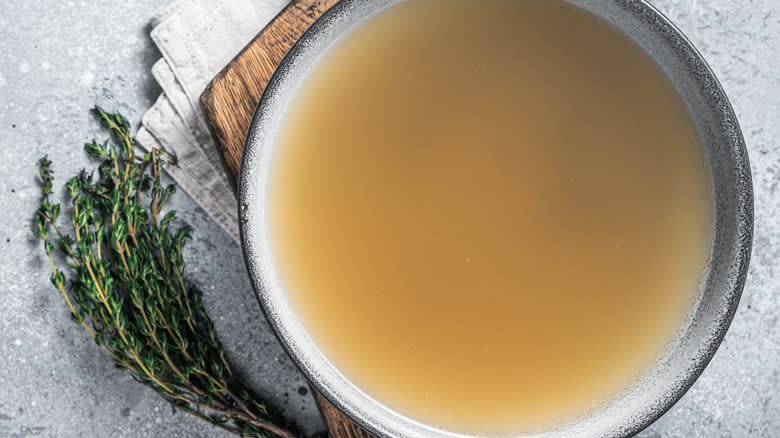
Water is essential to life on earth, but it's not vital for boiling your potatoes. If you want to enhance the taste of your potatoes without a lot of extra legwork, boiling in something other than water might be your best choice. Broth, whether you pick beef, chicken, vegetable, or something else on the market, can not only add a salty component but also allow the tubers to absorb some of the liquid. The broth is a great cooking liquid swap that you likely already have in your pantry. You may also use stock if you have that instead.
Check to see if the broth or stock is salted or sodium-free and take that into account when including or omitting salt in the boiling process. Broth can give cooked potatoes a nuanced flavor to your spuds, whereas something like heavy cream, or half and half can enrich the creaminess of your potatoes. Chef Tyler Florence ditches the water and substitutes it for a blend of heavy cream and either whole milk or half and half. Get rid of the water completely you won't need it if you're boiling it in one of these options.
Not Having Fun With The Add-Ins
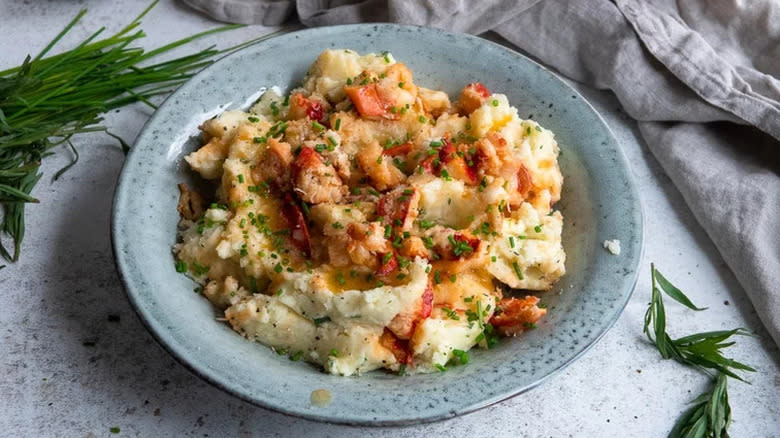
There are plenty of appetizing ingredients to toss in your mashed potatoes to give them an up-kick in flavor. Lobster mashed potatoes turn your weeknight meal into a delicacy that you'll crave long after it's devoured. Mash the spuds, and then add in the browned lobster meat. Don't over-mix the lobster so it falls apart or cooks further in the piping hot mash. This is best served fresh but should you have any leftovers, you can refrigerate them in an airtight container for no more than three days.
Apples are an unanticipated ingredient that you might want to consider popping in your potatoes. Together, they make a German dish called Himmel und Erde, which translates to "heaven and earth" in English. The potatoes and apples are boiled together so they're both able to get easily smooshed. This German dish is usually served on the chunkier side, so you don't have to twist your arm to get it completely smooth. If you'd like to lean toward the sweetness, add some sugar or keep it savory with caramelized onion and garlic. For something green, the classic Irish Colcannon mashed potatoes contain cabbage, but you could swap it for kale, spinach, or a different leafy green.
Forgetting To Pour In A Little Wine
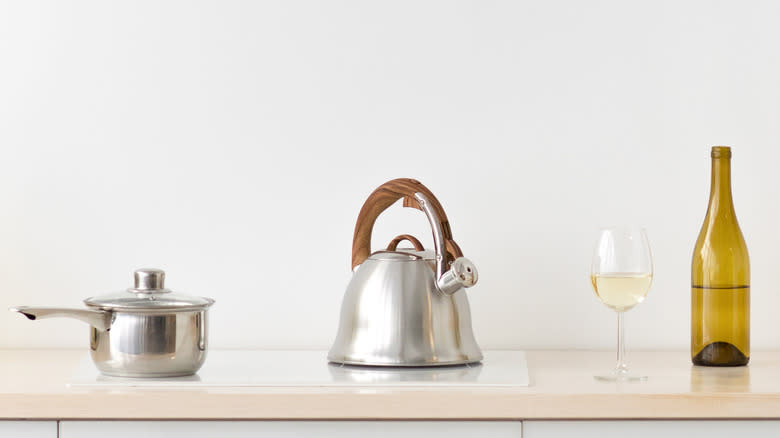
Wine is used to enhance the flavor of many dishes, boiled potatoes included, and you should use this same idea to give your smooshed spuds great depth. A little white wine is the key to transforming mashed potatoes into a complex, expensive-tasting dish. Simmer ½ cup of white wine until it reduces to around 2 tablespoons. For extra deliciousness, add onion and garlic to the wine as it reduces. At the end, stir in a pad of butter until melted and then it's time to add your wine glaze to the tots.
This stealthy addition won't take over your potatoes but instead will provide restaurant-quality potatoes that will leave your guests fighting over who gets the last serving. You can even use this with instant mashed potatoes. Since the wine gets reduced, it's more palatable and not as pungent as pouring wine directly into the mix. For even subtler flavor, add some white or red wine directly into the water to boil with the potatoes. Look to your wine's particular tasting notes to determine how it will taste on the palate. Whether you want something more fruity, citrusy, herbaceous, or floral truly depends on the wine that you have.
Using Only One Type Of Potato
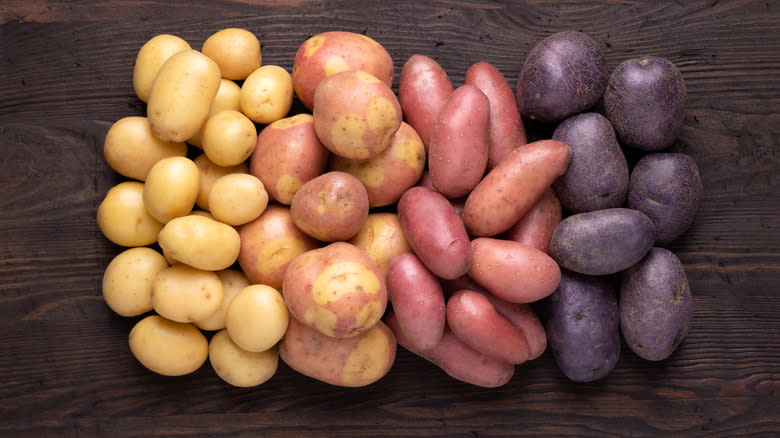
There are plenty of potato varieties out there to work with, whether you choose russet, fingerling, Yukon gold, or anything else. Many grocery stores tend to have the same popular options, so venture to your local farmer's market to spot other captivating options. It's a mistake to use one type of potato for your mashed potatoes as you can give them more intensity by mixing and matching.
Some potatoes are starchy while others are waxy, so for best results, try a combo of potatoes to hit the different groups. The key is balance for this particular hack. Use a combination of starchy potatoes and waxy to create a dynamic dish, such as pairing russet potato with Yukon Gold. You don't have to do a medley of several kinds of potatoes; a simple duo will do. Each potato has its unique qualities, densities, colors, and textures to create a complex dish. Experiment to find an ideal combination to suit your tastebuds.
Only Using A Masher
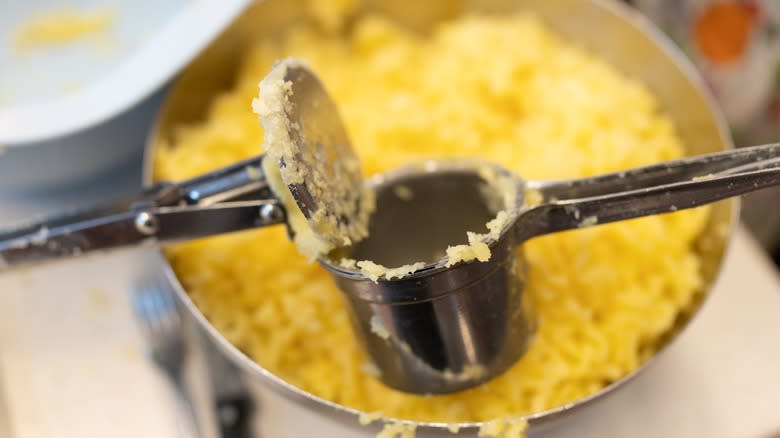
This is likely one of the top mistakes you're probably making with mashed potatoes, but it's a fast fix because there are plenty of ways to mash potatoes. However, if you don't happen to have this item in your kitchen or would like to test out alternatives, there are methods of making mashed potatoes. A fork works perfectly, and it's a kitchen staple. Yes, it might be a little bit more labor intensive since you're doing it by hand, but put on a podcast and you can get it done in a jiffy.
A ricer gives your potatoes a uniform texture, making it easy to achieve extra creamy mashed potatoes. A standard mixer or hand mixer works to do the brunt of the work rather than a hands-on method like a fork. The flexibility of an immersion blend allows you to move the device around to get the exact consistency you're craving. These tools turn your potatoes into a crowd-pleasing mashed delight whether you prefer a chunky or smooth potato.
Mixing In Cold Dairy Products
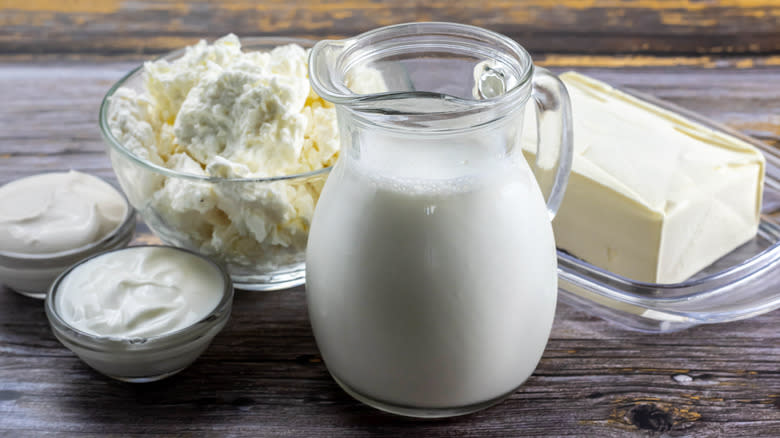
There is a magnificent range of dairy products to add to your spuds. Milk and butter are beloved, but there are heavier dairy options, like half and half, cream cheese, and sour cream. It doesn't matter which you end up using in your dish, but pre-warming them can make a big difference and potentially turn them into the best mashed potatoes you've ever had.
Everyone has probably put in cold butter from the fridge straight into mashed potatoes, getting frustrated when that last glob doesn't quite melt. For best results, warm up your dairy ahead of time. For butter, this can simply mean allowing it to reach room temperature. For milk, creams, and things like cream cheese, heat them on the stove. They don't have to reach boiling point but you want them to be warm. This hack ensures that you don't accidentally cool down your mashed potatoes. Refrigerated cold mashed potatoes are delicious, but reducing the temperature of the taters during the mixing process can make them stiff and ruin the consistency.
Read the original article on Tasting Table.

